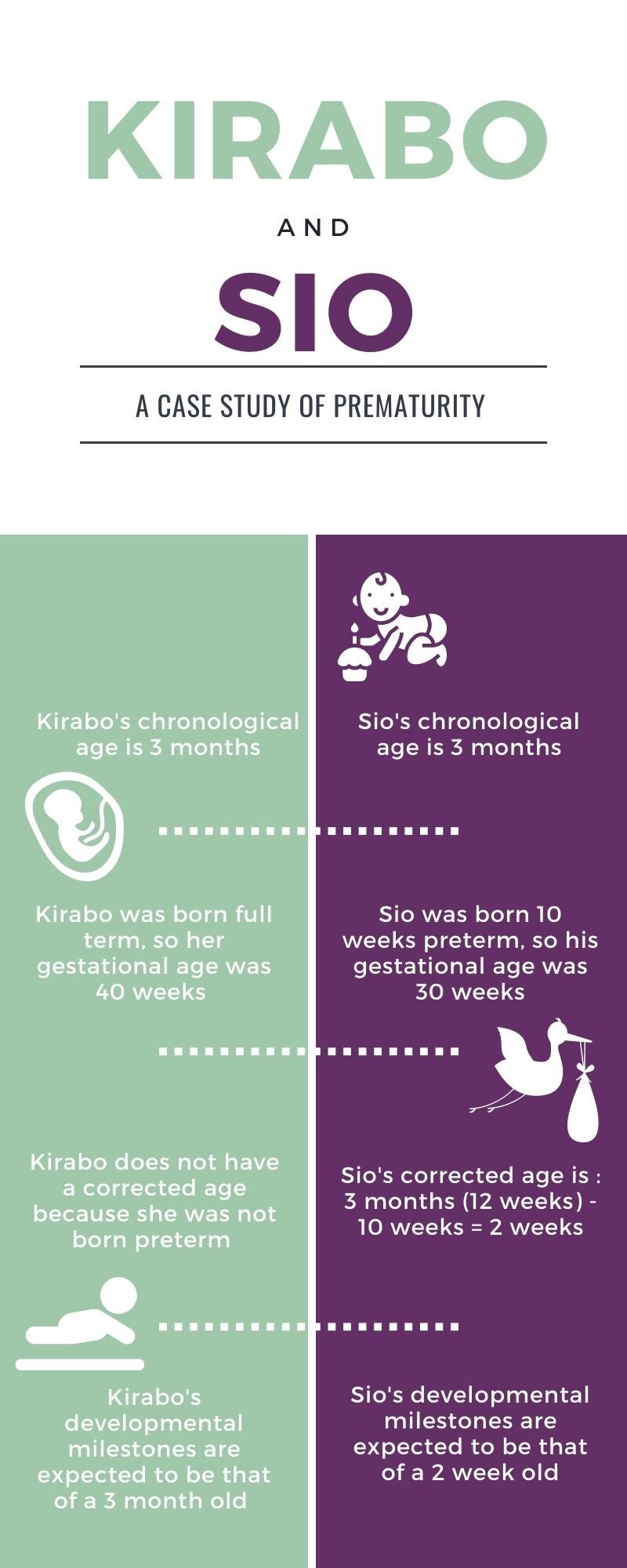What’s my age again?! Breaking down chronological age vs. corrected age in preemies
Did you know that 1 in 10 babies are born preterm in the US? That’s a lot of babies! Preemies are a large portion of the population I work with at the hospital and other settings. Chances are, you know someone who was born early too!
Babies go through immense amounts of growth in utero, with especially important changes occurring in the last several months of pregnancy. When babies are born prematurely, these critical periods of development are required to take place in the harsh outside world. Therefore, these babies need extra protection and care, often resulting in a NICU stay. Due to advances in medical care, babies are able to survive at younger ages, but there are certain developmental and health risks that come with prematurity that are important to be aware of.
I’ll go into more detail about developmental risks and strategies to support premature babies in future posts, but for now I’m going to break down the importance of understanding age. Knowing the intricacies of your baby’s age(s) is crucial for optimizing care, setting realistic expectations, and identifying delays and need for intervention.
So really, what is my age again?!
If you are a parent or caregiver of a preemie, you’ve likely been flooded with a plethora of terms used to describe your babies age. Gestational age? Chronological age? Corrected age? Adjusted age? Post-menstrual age? Gahhhh! Trying to keep track of all your baby’s “ages” can make your head spin! But FEAR NOT! I’m here to clear up confusion and make sense of ages for all my teeny tiny preemie friends!
If your baby is a preemie, there are two important dates to mark on your calendar to keep track of ages:
Your baby’s actual date of birth
Your expected due date
These dates will help us calculate ages and keep track of timelines for our preemie friends.
But let’s make sure we are all on the same page to start with by defining prematurity. A full term pregnancy is typically 40 weeks, give or take a couple of weeks. Any baby born at less than 37 weeks is considered preterm. A baby born between 32-37 weeks is categorized as moderate-late preterm, 28-32 weeks is considered very preterm, and less than 28 weeks is extremely preterm. And yes, these are the actual medical terms.
To helps us make sense of calculating ages in preemies, we are going to enlist the help of my theoretical bebe friends, Kirabo and Sio (they are characters in my latest fave book, if you must know!). Kirabo and Sio were born on the same day, and they are both 3 months (or 12 weeks) old today! Kirabo was born full term at 40 weeks. Sio was born 10 weeks preterm at 30 weeks.
Now, let’s break down the definitions of commonly used terms to describe age:
Gestational age: this is how many weeks were completed in pregnancy, from the last menstrual period to delivery. In our example, Kirabo was born full term, so her gestational age was 40 weeks. Sio was born preterm, making his gestational age 30 weeks.
Chronological age: this is the easiest age to calculate, and the way most of us count how old we are. It is the actual number of days, weeks, or months that have passed since your baby was born, irrespective of prematurity. In our example, Kirabo’s chronological age is 3 months. Sio is also 3 months old chronologically.
Corrected age: also commonly referred to as adjusted age, this is where things get tricky! Corrected age is when we take prematurity into consideration, and subtract the baby’s weeks or months of prematurity from their chronological (actual) age.
The formula looks like this:
chronological age - weeks of prematurity = corrected age.
In our example, Kirabo was born full term so does not have a corrected age. Sio was born 10 weeks preterm, so we calculate his corrected age like this: 3 months (12 weeks) - 10 weeks = 2 weeks. Sio’s corrected age is 2 weeks.
Post-menstrual age (PMA): this is most commonly used during the perinatal period (the weeks immediately before and after birth) and is rarely used outside of the NICU setting. It refers to the age of the baby since conception, including gestational age and chronological age. For example, Sio was born at 30 weeks gestation. When he was 10 weeks old chronologically, his PMA was 40 weeks.
Let’s review…
Here’s the age breakdown of our two bebe friends
Clear as mud?
Great! The good news is you don’t have to do all the calculations yourself! Here is an online prematurity calculator to help you quickly figure out your baby’s chronological and corrected ages.
Here are the results using the Preemie Calculator for our friend Sio!
Why do we correct for prematurity?
Good question! When a baby is born preterm, there is a lot of growing and developing that still needs to occur in their brains and nervous systems, and this dictates a baby’s sensory and motor development. They can’t (and shouldn’t!) be expected to perform or develop along the same timeline as a full term baby. For this reason, we correct/adjust for prematurity to more accurately reflect how the baby is doing and what to watch for.
Correcting for prematurity is important to set realistic expectations, track growth and development, and identify potential delays. We continue to correct for prematurity for at least the first 2 years of life.
When I assess a baby, I always correct for prematurity when evaluating motor skills. If I were to assess bebe Kirabo’s motor skills right now, for example, I would expect to see emerging head control and reaching skills. These are typical milestones for a 3 month old baby.
When assessing Sio, however, I correct for his prematurity. This means I expect him to be performing milestones that are typical for that of a 2 week old baby.
Tummy time starts early, even in the NICU!
PT can be helpful for preemies!
PT can be an essential aspect of your premature baby’s health plan. If you aren’t already connected with an infant PT, talk to your pediatrician about getting an assessment, and be sure to correct for prematurity when looking at milestone expectations! See my previous blog post on milestones for more information. This is a vast and important topic, so I’ll be expanding on it later.
TL; DR
1 in 10 babies are born prematurely, and it’s important we understand their ages in order to set realistic expectations, track growth and development, and identify delays.
Prematurity is defined as a baby born at less than 37 weeks of pregnancy. 32-37 weeks is considered moderate-late preterm, 28-32 is very preterm, and less than 28 weeks is extremely preterm.
It is important to know your baby’s birth date and expected due date to calculate ages related to prematurity.
Chronological age is your baby’s actual age, or how many days, weeks, or months have passed since birth. Corrected age is their chronological age minus their weeks/months of prematurity. For example, if a baby is 3 months (12 weeks) old and was born at 30 weeks (10 weeks preterm), their corrected age is actually 2 weeks.
We always correct for prematurity when assessing development, until at least the age of 2.
There are developmental and health risks that can be associated with prematurity, and PT is a vital part of your preemie’s health plan! Contact your pediatrician for an assessment.




